The following lines were written by Neva, who spent several years living in Switzerland. Her memories, experiences, and impressions are shared here in her own words.
From Slovenia
My name is Neva Stiglic, I live in Maribor, in Slovenia.
In my presentation I will talk about our life in Switzerland between July1989 and June1993.
I will briefly tell you about where we lived before, and make a quick comparison between Switzerland and Slovenia, about Suss food, show you a few famous places in Neuchâtel, and most importantly, about our family life at the time.
Before we moved, we were living in Ljubljana in an apartment block on one of the main streets.
The street (on picture below) was and still is, very busy and noisy. It was most disturbing at night because we had a bus stop right below the block. And you can imagine how loud it was every time the bus stopped and started again.
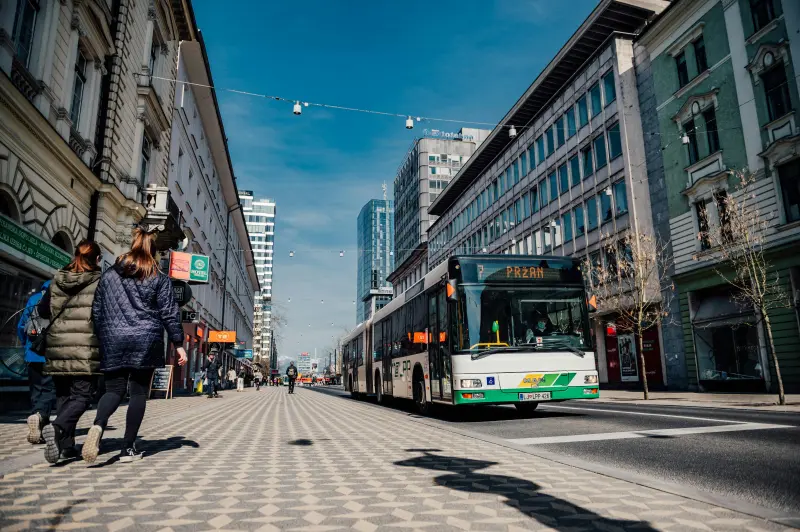
The air was polluted by traffic and coal burning. The facades were mostly unattractive, and in winter there was fog.
But this is the past, passe! Nowadays Ljubljana is very attractive city.
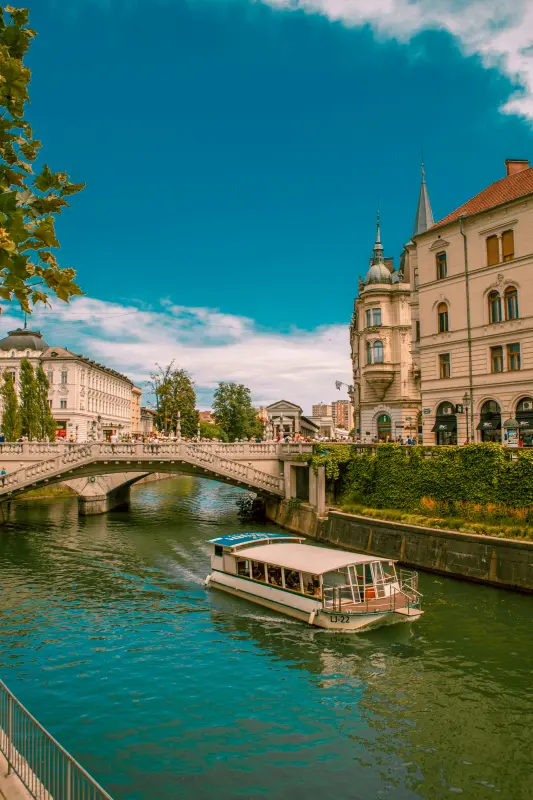
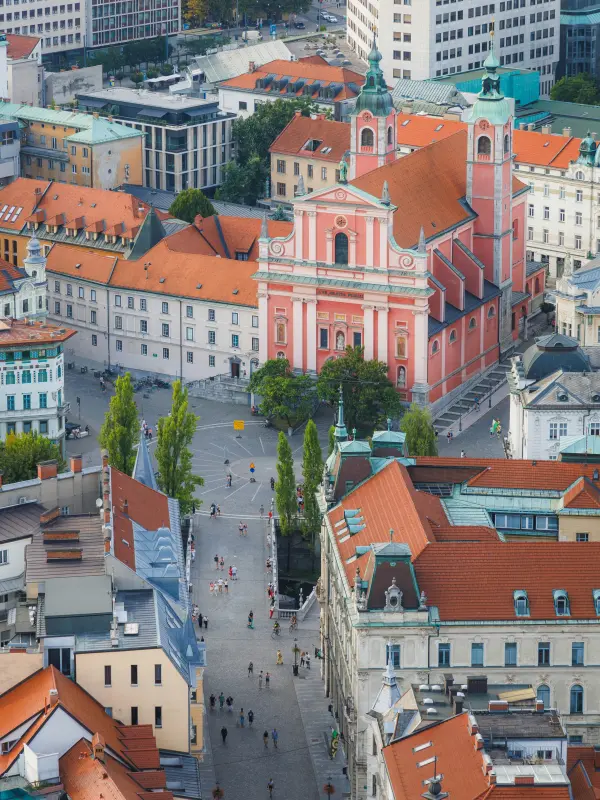
In 1989 we were young family with two kids.
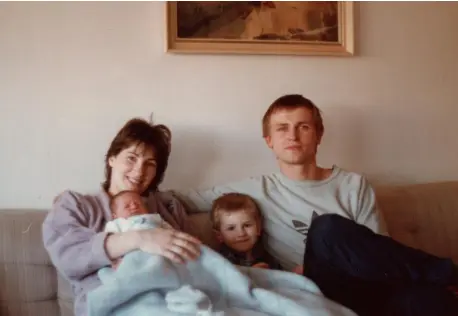
We were both employed, I was working at the pharmaceutical company Lek (now Novartis).
My husband Maks worked in the field of microelectronics and was looking for work abroad.
My youngest son was born in February 1989 and I was on maternity leave.
Our older son Mitja, was 4 years old and attended kindergarten.
In January 1989, Maks went for an interview in Switzerland, in Neuchâtel, and in few months, he signed a contract. He got a job as a microelectronic design engineer in a company belonging to the Swatch group.
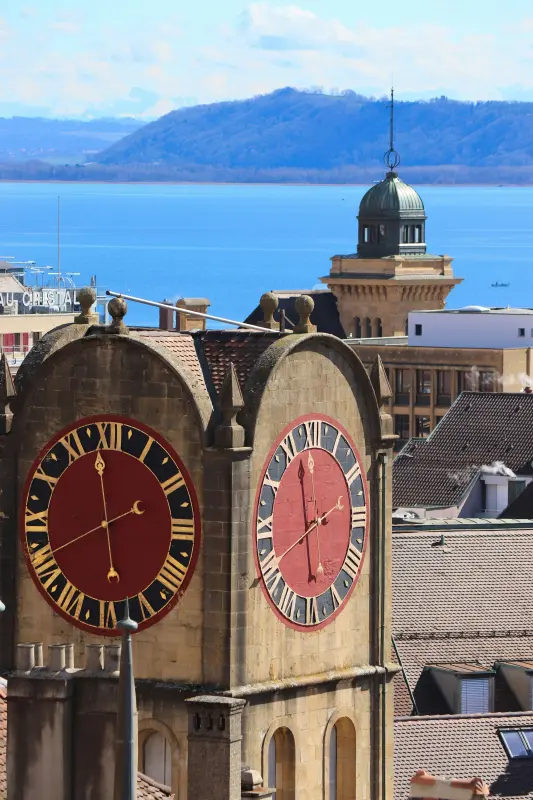
Maks started working on April 2nd and in his free time he was looking for an apartment. He was helped by some people from the company. He soon found an apartment in Enges, so we could move there.
We left in July 1989, younger son Vid was only 4 months old at the time, and I remember the journey well, because he cried for almost 4 hours before falling asleep, and it was pouring rain on the road.
There are two main routes to Switzerland, one through Austria and the other through Italy, which we used most often.
On the relief of Switzerland, you can see the southern region with the Alps and the northern region of the Jura, with the plateau in between populated with larger cities (Bern, Zurich, Lausanne, Geneva).
The best-known mountain is Matterhorn, Switzerland’s most famous landmark. 4478 m hight and with its characteristic pyramid-shaped silhouette.
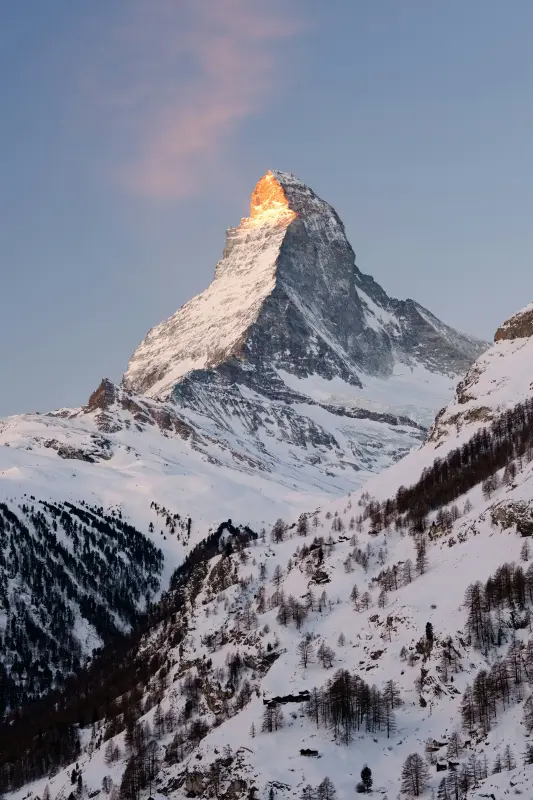
How many languages are spoken in Switzerland?
German 63%, French 23%, Italian 8%, Romans 0,5%
What is the origin of Red-Cross Symbol
The symbol of the International Committee of the Red Cross is an inverted Swiss flag as a tribute to Henry Dunant, a citizen of Switzerland, who founded it in 1863
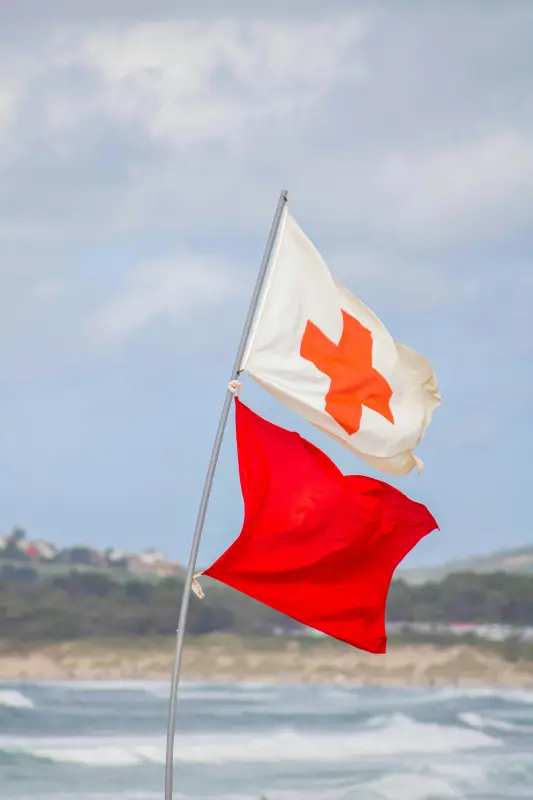
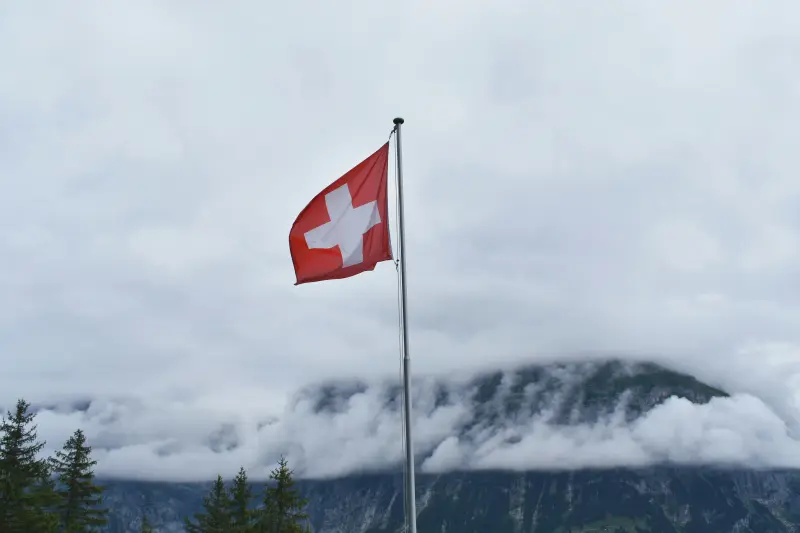
What is the meaning of Neuchâtel?
Newcastle
Neuchâtel is a town, municipality and the capital of Swiss Canton of Neuchâtel and Neuchâtel is the center of the Swiss watchmaking industry, a place of microtechnology and high-tech industries.
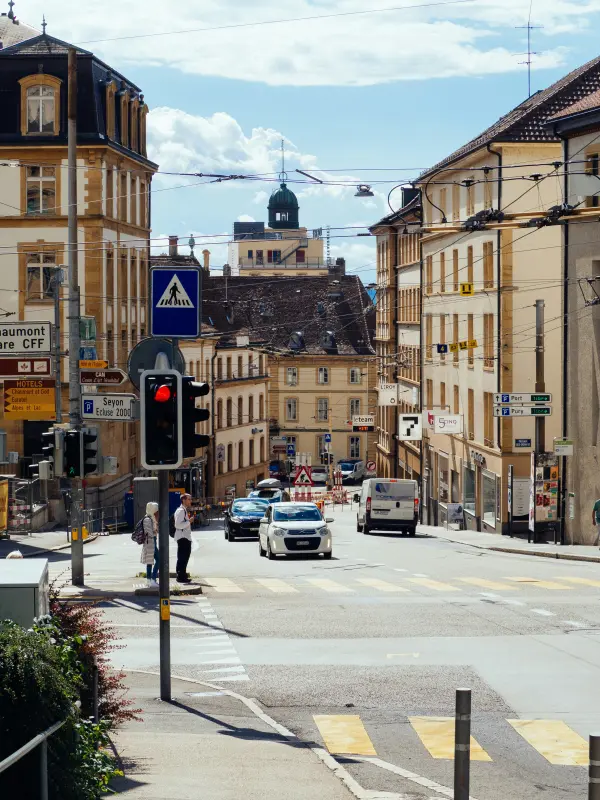
It is also known for its French language courses.
The city lies at the foot of Mount Chaumont (1180m). There is also the cable-car and from the top you can admire whole region with the lake.
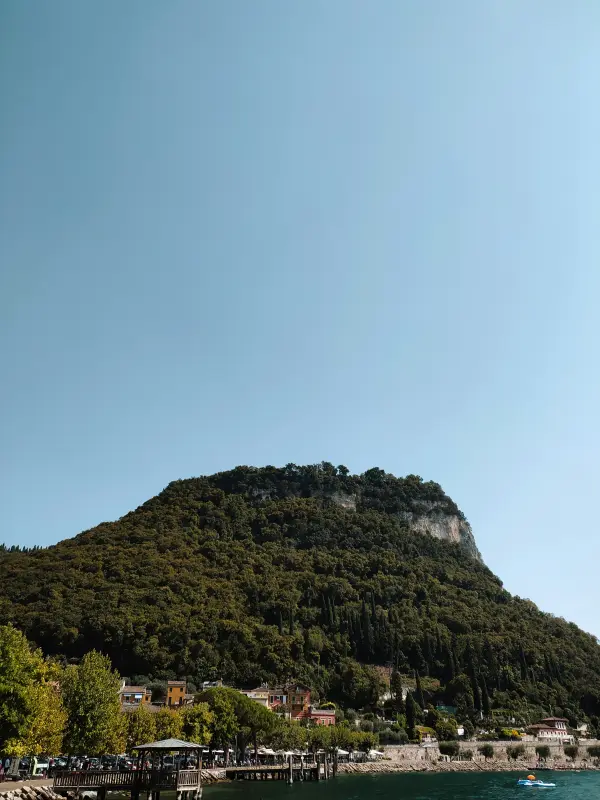
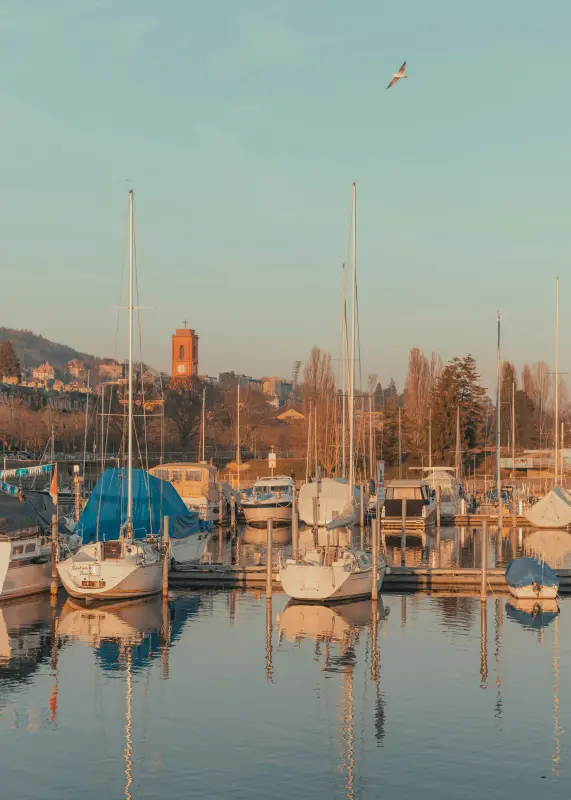
What is the meaning of the word Enges in French?
Enges is pronounced the same as anges in French, and it means angels.
It is located at an altitude of 800 m about the sea level, there is 272 habitants.
At that time there were only 50 households. Some of them were farmers.
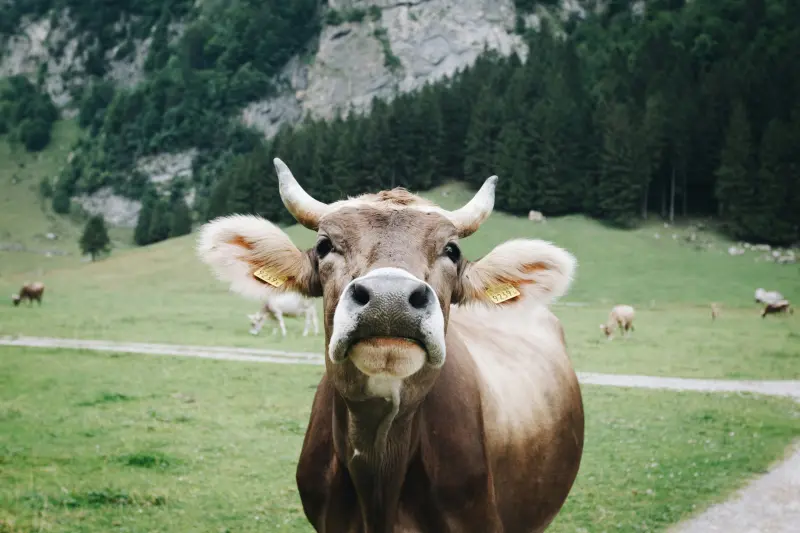
The farmer, our neighbour had a farm opposite us and they raised calves, about 50 calves.
Our house was the same as this one, except it was set back and facing differently. The apartment was on the 2nd floor.
Cows were grazing in the nearby meadow. Since they had bells, we could hear them very well. In winter there were a lot of clouds, but they were below us, so we had a lot of sun.
The road leads further up the hill to the school and to the larger Chasseral mountain and of course in the opposite direction to Neuchâtel.
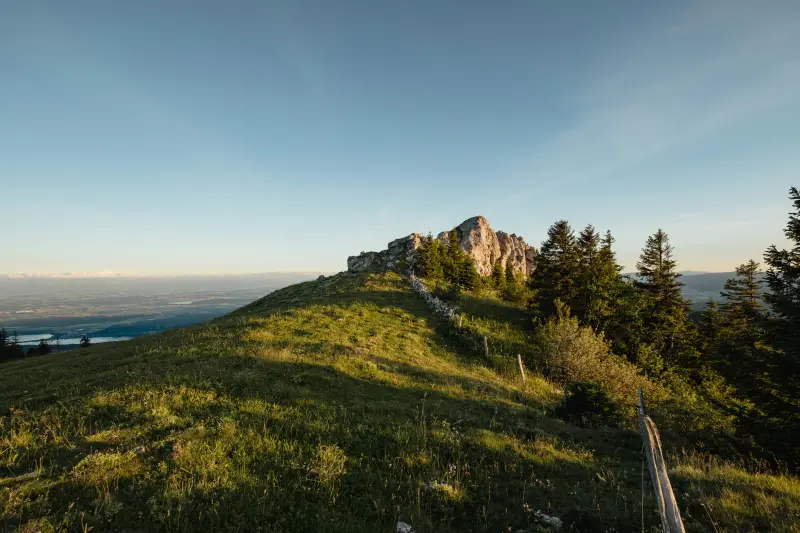
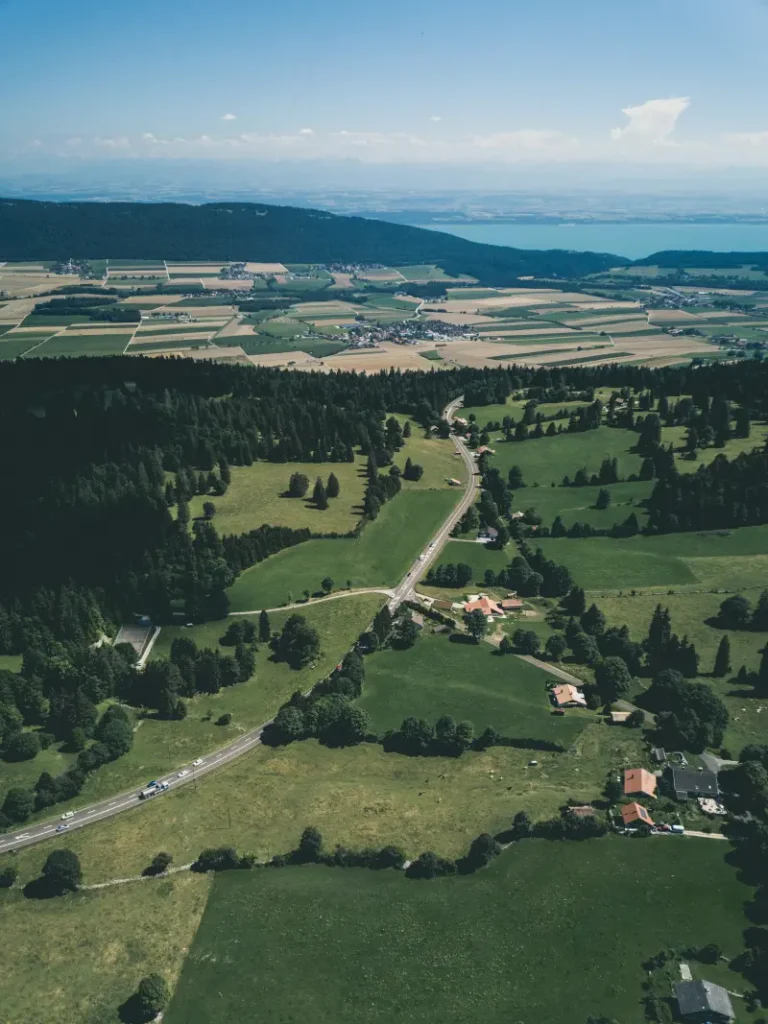
At first, we were pretty much alone.
I spoke little English; my husband spoke good English and bad French. But soon invitations started coming, the first one was from our neighbours who lived in a house very close to us.
Their daughter was celebrating her 2nd birthday and they invited the whole neighbourhood.
This allowed us to get to know all the neighbours faster and later made contact in the yard and playground. It was easier with the children.
In the beginning, I used English to communicate. Some of the neighbours spoke English, and in the first block English speaking family was living. The lady was American and her husband was English; they have two kids.
And there was also another neighbour family with the young kids. This family, who lived in a house near us had two children, girl at the same age then Mitja and son had at that time 8 month. Our children quickly got along with them. Their mother was the most helpful to me over time.
I was very grateful that Mitja and Vid were able to make contacts, even though They didn’t know the language.
On weekends and holidays, other neighbours had visits from relatives and friends, but we were alone.
We enjoyed walks along the shore the most, swimming in the lake and nearby pool in the summer, and playing on the playgrounds for the children. It was sometimes difficult for Mitja because he watched the others play. But soon they invited him to join them, so there was no need to nag his brother Vid.
We enrolled our son in a Montessori kindergarten, which at that time had opened a French-language group for locals and had an English-language group.
It was funny from the beginning because he spoke Slovenian with a French accent, but later on, more and more Slovenian words were replaced by French.
I also started listening to the radio and watching television in French.
We had also visits from Slovenia our parents come around so we were very glad.
We visited together some interesting places like La Tene by the lake, once we visited the park nearby, where they also had domestic animals such as sheep, goats, guinea pigs, hamsters, ducks and geese, and several types of hens. We visited also Museum of art and history, because this museum holds something special. There we could admire the world’s first known robots, dating back to the 18th century.
What do these robots even look like?
The three automated figures – the Artist, the Writer and the Musician – built between 1768 and 1774, by the clock maker and mathematician, Pierre Jaquet-Droz, and his son, mechanic and musician Henri- Luis are the most perfectly preserved in the world. Jacquet-Droz was also responsible for creating one of the first artificial arms ever in Europe.
The writer can write a sentence with perfect handwriting, which can consist of up to 40 letters. While writing, the head follows the movement of the pen and dips it in ink as needed.
The robot has complex mechanics in its chest.
The Musician is the model of a young girl seated at a clavichord, on which she is playing at least three tunes with the pressure of her own fingers. On closer inspection, you can notice that there was a small heart beat visible at the centre of her chest.
When set in motion, the Artist drew perfect sketches of a dog and the profiles of Britain’s King George III and his wife, Charlotte.
In a similar way, the Artist dropped his head every time a drawing was half finished, the artist would bow his head and blow to dry the paper.
However, in the second year of our stay, I decided to take a French course and actively started learning.
I remember that once, when we met, my American neighbour, who asked me something and I felt like someone had hit me on the head… I couldn’t answer either in English or French! She just waved her hand and said, nothing important, let’s talk some other time!
But the children sometimes laughed at me if I said something strange!
What Swiss made chocolates do you know?
Lindt and Sprüngli emphasizes high-quality cocoa beans sourced from specific regions known for their flavour profiles. They often use high cocoa content and avoid artificial additives, some
We tasted some good chocolates.
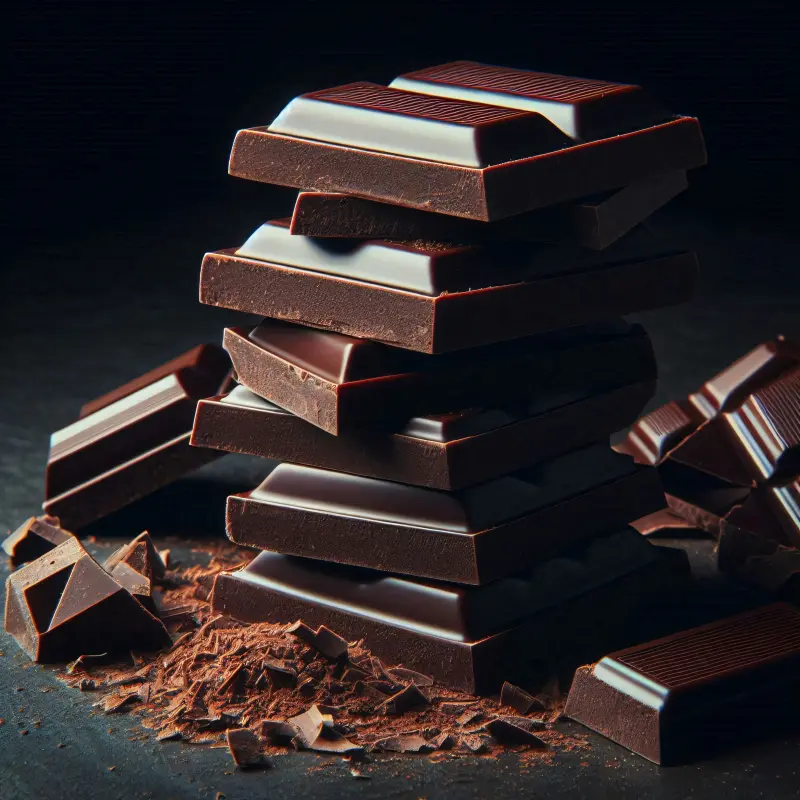
It is interesting that Swiss eat chocolate with bread for a snack they eat (also adults).
In 1847, the British company Fry & Sons produced the first solid chocolate, a mixture of cocoa powder, cocoa butter and sugar. This was the beginning of chocolate production in the form we know today. The Swiss soon followed the British example and in 1875, Daniel Peter, a Swiss chocolatier, created the first milk chocolate with the addition of condensed milk, which was made by Henri Nestlé.
1879: The Invention of Conching
Meanwhile in Berne, Rodolphe Lindt, the son of a pharmacist, just started a small confectionery. Shortly after opening in 1879, Lindt’s chocolate company Rod. Lindt & sons only produced hard, bitter chocolate, just like all other chocolatiers at that time. Undeterred, Lindt kept experimenting, until one Friday night after months of testing, he left his factory without turning off the conching machine. It churned all night and all through the weekend. The chocolate Lindt found on Monday was delicately smooth and tasted like it never had before. Chocolate was changed forever. That was the beginning of incomparably delicate, world-renowned Lindt chocolate fondant.
The secret to his chocolate was all in the conching process he had invented which created a fine-melting texture by evenly combining the cocoa mass and cocoa butter with other ingredients like sugar and milk for a prolonged period of time, Lindt’s conching technique created a ‘melting chocolate’ so fine and so flavourful it was impossible to resist. This was the start of a chocolate revolution. Lindt kept his invention top secret until the Sprüngli’s came into the picture. Until today, conching is used by chocolate manufacturers all over the world.
Switzerland is also famous for cheese
Many cheses are originating from there, like Gruyère and Emental for example.
There are two famous dishes based on swiss cheese,
and fondue ( 50% de Gruyère et de 50% de Vacherin Fribourgeois)
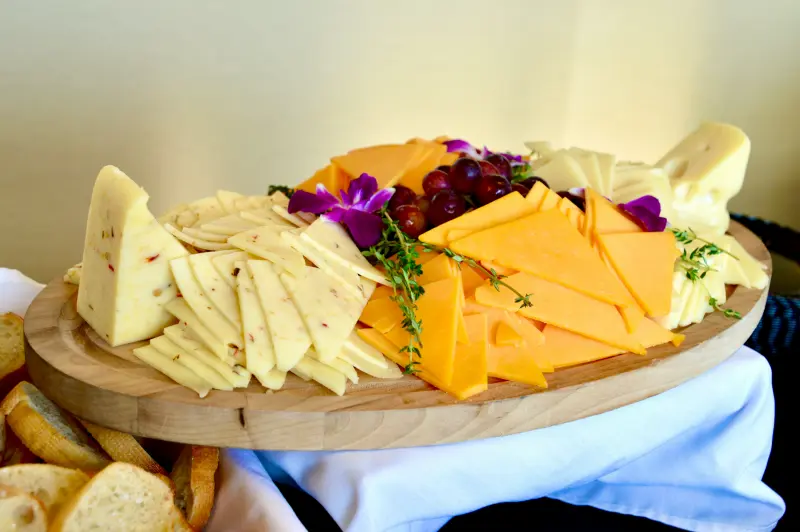
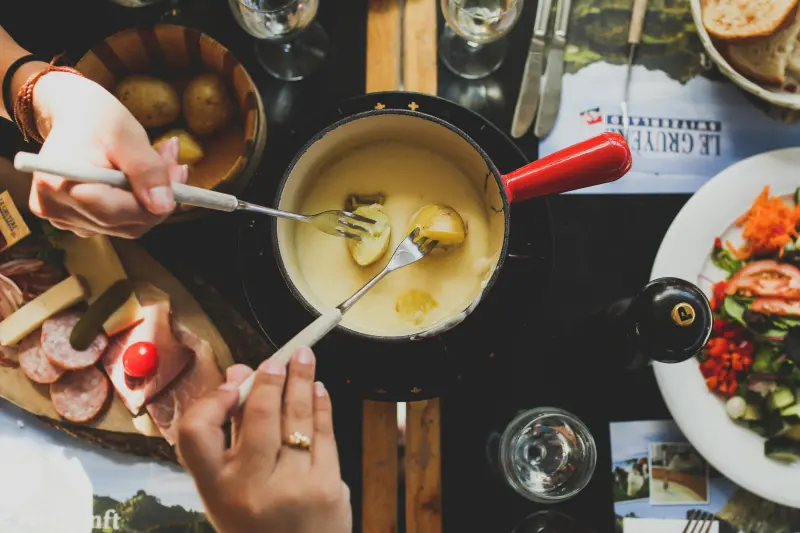
When I finished my French course, I started taking French lessons with an old and experiences professor of French and German who taught foreigners. She taught in the classical way, like she used to do in school.
My neighbour suggested that I join a mixed choir. I really enjoyed it because our neighbours and people from the village were there, it was fun.
The choirmaster was an old man, but very democratic. We chose the songs we sang
together, and it was also strange to me when we voted on what to wear for the performance.
By the way, did you know that Swiss are champions of direct democracy. They have referendums four times per year and there may be several subjects on which they vote every time. When we were living there was for example a referendum about increasing speed limits on motorway, and guess what, it failed.
We sang Swiss songs like Tout au long du Doubs, Beau Jura, and songs from other countries. I remember singing a song from the traditional Slovakian song:
Tancuj, tancuj, vykrúcaj, vykrúcaj,
len mi piecku nezrúcaj, nezrúcaj,
dobrá piecka na zimu, na zimu,
nemá každý perinu, perinu.
(Tralala, tralala, tralalala lalala, lalala.): ….(dance, dance,twirl,twirl,just don’t knock down my oven,don’t knock down good stove for winter, not everyone has a duvet, a duvet …)
We had concerts for the villagers at Christmas time and we also performed in a nursing home.
The school was something special. It was located in the geographical center of the local community, about 1 km up the hill, but there was a beautiful view of the Alps.
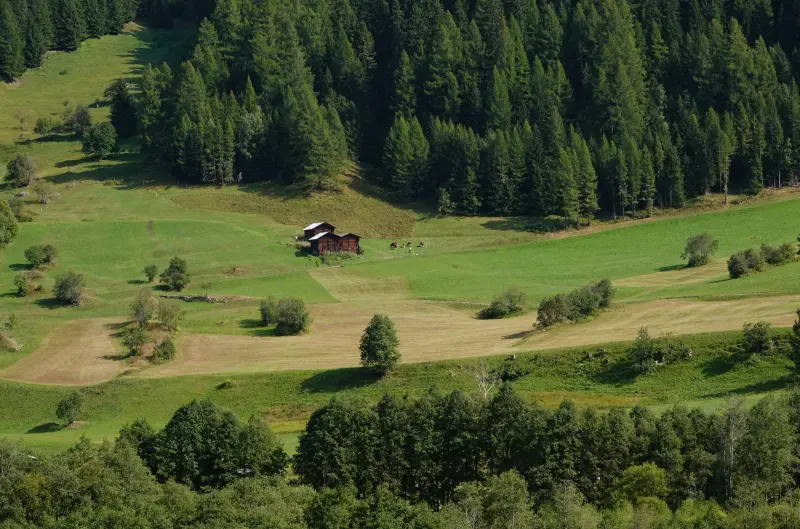
The school only had 20 children for 5 grades (primary schools in Switzerland have 5 grades), children from first 3 grades were studying together, and children of the next two grades together. Our son had 3 classmates in the same grade. The school was closed during lunch. The children came home for lunch. Later they returned to school for afternoon lessons. He walked a lot. When the weather was bad, I changed Mitja’s clothes twice a day. They had breaks outside. I remember that he was never sick. I remember that in those two years he was never sick.
School building with fantastic view of the Alps
Our son on first school day
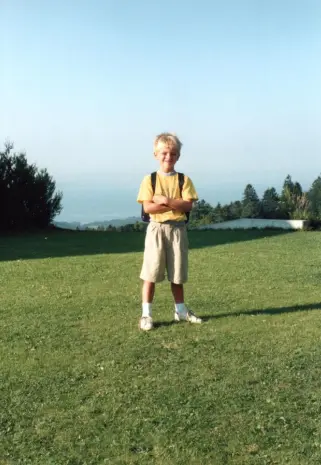
I also remember an incident later, when Mitja was already going to school.
The teacher arranged to consult with me by phone. I thought she also mentioned that she would come straight to my house in the afternoon, because she was driving past our house anyway.
But that wasn’t the case. Maks and I waited at home, and she was at school. After a while, Maks called the school anyway, and that’s how we discovered the misunderstanding.
…and of course we went to school. But I won’t talk about my husband’s bad mood …
Since food was more expensive in Switzerland, especially meat, many Swiss who lived near the French border went shopping in Pontallier or some other place.
We were told that you could bring 1 kg of meat per person without paying duty.
So we went shopping too.
The result, of course, was that we bought a lot more than we thought, because we had big eyes. I remember a white stuffed cat. He was very cute, with soft white fur and big green eyes. Vid liked it so much that he didn’t want to let it go…and it ended up in the shopping cart.
When we were returning and stopped at the border, the Swiss customs officer asked if we had anything to declare. We said it was meat. We found out that it was a kilo too much because they don’t count children.
This fact came as a unpleasant surprise to us. He said that next time we should take into account what exactly is allowed and then let us go home.
Vid started going to one lady’s nursery twice a week to learn French. She looked after the children and also prepared lunches for school-age children whose parents were at work. She was helped by two babysitters.
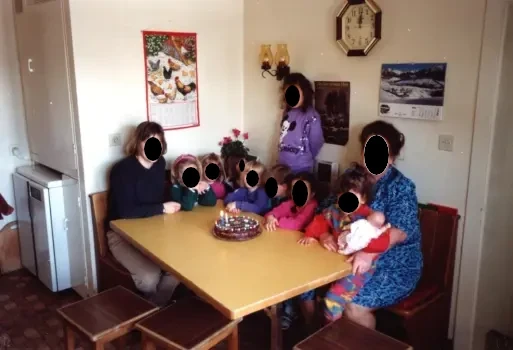
Once, when Max went to pick him up, he came to the apartment to look for Vid, but he wasn’t there. The front door was open, or rather, he was so big that he could open the front door. The door to the yard was also open, and that’s how he got to the street. Vid was walking towards the bridge when Maks saw him. Luckily, there was no traffic.
When Maks asked him why he had gone out the door alone, he replied that he wanted go home. From then on, that lady always locked all the doors.
In 1992, Maks and I realised that we have to decide whether to stay in Switzerland or go home. Mitja, was 7 years old and could start school in Slovenia next year.
We have realised that we have to decide what to go back to Slovenia or the stay. As the children enter in the adolescence it is very difficult for them to change the environment. In addition, Slovenia had gained independence the year before so the prospects there were good.
As we decided to move home Maks managed to get a contract to continue working for the Swiss company from Slovenia.
1994 Our family has grown, my daughter was born
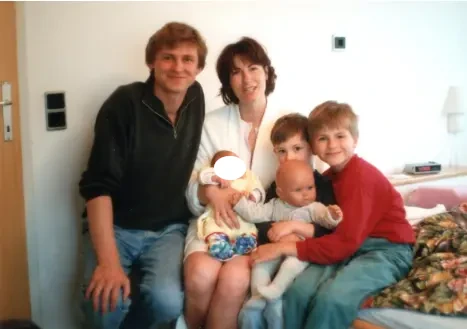
We are still in touch with our french friends.
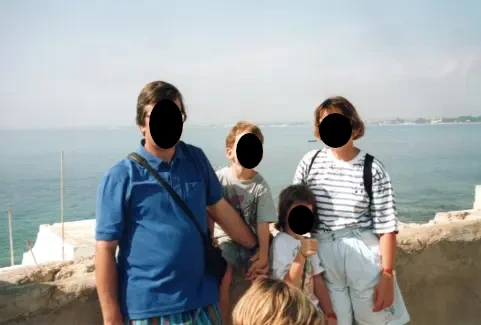
Thank you very much for listening.